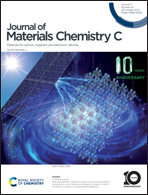Surface chemical mechanisms of trimethyl aluminum in atomic layer deposition of AlN†
Abstract
Aluminum nitride (AlN) is an important material for semiconductor devices, such as ultraviolet light emitting diodes (LEDs) or high-electron-mobility transistors (HEMTs). One emerging approach to deposit very thin, and highly conformal AlN films is atomic layer deposition (ALD), most commonly by using trimethyl aluminum (TMA) and ammonia. Despite TMA being one of the most common ALD precursors, its surface chemistry in ALD of AlN is poorly understood. By quantum chemical modeling, we have investigated the adsorption and decomposition of TMA on an AlN surface. We have found two competing decomposition pathways, either ligand exchange by protonation of the methyl groups in TMA by a surface amino group, or reductive elimination of the methyl groups as ethane. Reductive elimination is shown to be the dominating reaction step if a TMA molecule adsorbs far from any previously adsorbed molecule. Ligand exchange is preferred if it adsorbs close to an already adsorbed molecule. By comparing the obtained surfaces after decomposition, we find that the saturation coverage is dependent on the preferred pathways with a third of a monolayer saturation for reductive elimination and a full for ligand exchange. The relative low diffusion rate compared to decomposition rate of TMA will cause the molecules to be far apart after adsorption, and we conclude that the dominating decomposition path is reductive elimination.

- This article is part of the themed collection: #MyFirstJMCC


 Please wait while we load your content...
Please wait while we load your content...